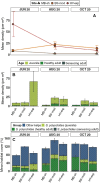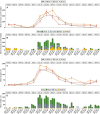Spatiotemporal variability in population demography and morphology of the habitat-forming macroalga Saccorhiza polyschides in the Western English Channel
- PMID: 37962600
- PMCID: PMC10921834
- DOI: 10.1093/aob/mcad181
Spatiotemporal variability in population demography and morphology of the habitat-forming macroalga Saccorhiza polyschides in the Western English Channel
Abstract
Background and aims: Large brown macroalgae serve as foundation organisms along temperate and polar coastlines, providing a range of ecosystem services. Saccorhiza polyschides is a warm-temperate kelp-like species found in the northeast Atlantic, which is suggested to have proliferated in recent decades across the southern UK, possibly in response to increasing temperatures, physical disturbance and reduced competition. However, little is known about S. polyschides with regard to ecological functioning and population dynamics across its geographical range. Here we examined the population demography of S. polyschides populations in southwest UK, located within the species' range centre, to address a regional knowledge gap and to provide a baseline against which to detect future changes.
Methods: Intertidal surveys were conducted during spring low tides at three sites along a gradient of wave exposure in Plymouth Sound (Western English Channel) over a period of 15 months. Density, cover, age, biomass and morphology of S. polyschides were quantified. Additionally, less frequent sampling of shallow subtidal reefs was conducted to compare intertidal and subtidal populations.
Key results: We recorded pronounced seasonality, with fairly consistent demographic patterns across sites and depths. By late summer, S. polyschides was a dominant habitat-former on both intertidal and subtidal reefs, with maximum standing stock exceeding 13 000 g wet weight m-2.
Conclusions: Saccorhiza polyschides is a conspicuous and abundant member of rocky reef assemblages in the region, providing complex and abundant biogenic habitat for associated organisms and high rates of primary productivity. However, its short-lived pseudo-annual life strategy is in stark contrast to dominant long-lived perennial laminarian kelps. As such, any replacement or reconfiguration of habitat-forming macroalgae due to ocean warming will probably have implications for local biodiversity and community composition. More broadly, our study demonstrates the importance of high-resolution cross-habitat surveys to generate robust baselines of kelp population demography, against which the ecological impacts of climate change and other stressors can be reliably detected.
Keywords: Saccorhiza polyschides; Furbelows; foundation species; habitat-former; kelp; macroalgae; marine forests; ocean warming; seasonality; seaweeds; temperate rocky reefs; wave exposure.
© The Author(s) 2023. Published by Oxford University Press on behalf of the Annals of Botany Company.
Figures







Similar articles
-
The structure and diversity of macroinvertebrate assemblages associated with the understudied pseudo-kelp Saccorhiza polyschides in the Western English Channel (UK).Mar Environ Res. 2024 Jun;198:106519. doi: 10.1016/j.marenvres.2024.106519. Epub 2024 Apr 23. Mar Environ Res. 2024. PMID: 38678754
-
Could the annual Saccorhiza polyschides replace a sympatric perennial kelp (Laminaria ochroleuca) when it comes to supporting the holdfast-associated fauna?Mar Environ Res. 2022 Dec;182:105772. doi: 10.1016/j.marenvres.2022.105772. Epub 2022 Oct 18. Mar Environ Res. 2022. PMID: 36279675
-
Hydroids (Cnidaria, Hydrozoa) from Mauritanian Coral Mounds.Zootaxa. 2020 Nov 16;4878(3):zootaxa.4878.3.2. doi: 10.11646/zootaxa.4878.3.2. Zootaxa. 2020. PMID: 33311142
-
Threats and knowledge gaps for ecosystem services provided by kelp forests: a northeast Atlantic perspective.Ecol Evol. 2013 Oct;3(11):4016-38. doi: 10.1002/ece3.774. Epub 2013 Sep 15. Ecol Evol. 2013. PMID: 24198956 Free PMC article. Review.
-
Forgotten underwater forests: The key role of fucoids on Australian temperate reefs.Ecol Evol. 2017 Sep 10;7(20):8406-8418. doi: 10.1002/ece3.3279. eCollection 2017 Oct. Ecol Evol. 2017. PMID: 29075458 Free PMC article. Review.
Cited by
-
The influence of seeding method and water depth on the morphology and biomass yield of farmed sugar kelp (Saccharina latissima) at a small-scale cultivation site in the northeast Atlantic.J Appl Phycol. 2025;37(1):459-470. doi: 10.1007/s10811-024-03394-9. Epub 2024 Dec 16. J Appl Phycol. 2025. PMID: 40083773 Free PMC article.
-
Victim of changes? Marine macroalgae in a changing world.Ann Bot. 2024 Mar 8;133(1):1-16. doi: 10.1093/aob/mcad185. Ann Bot. 2024. PMID: 37996092 Free PMC article. Review.
References
-
- Anderson MJ, Gorley RN, Clarke KR.. 2008. Permanova+ for primer: guide to software and statistical methods, Plymouth, UK: PRIMER-E Ltd.
-
- Araújo RM, Assis J, Aguillar R, et al. . 2016. Status, trends and drivers of kelp forests in Europe: an expert assessment. Biodiversity and Conservation 25: 1319–1348.
-
- Arnold M, Teagle H, Brown MP, Smale DA.. 2016. The structure of biogenic habitat and epibiotic assemblages associated with the global invasive kelp Undaria pinnatifida in comparison to native macroalgae. Biological Invasions 18: 661–676.
MeSH terms
Grants and funding
LinkOut - more resources
Full Text Sources
Research Materials
Miscellaneous

